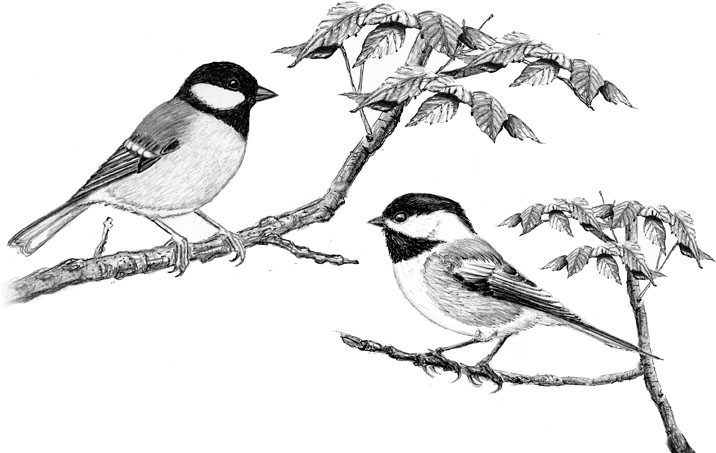
Rare bird sighting in Orleans (and this is true).
For years I’ve been reading and writing about folks who have had unusual birds coming to their yards. Every time I hear about, say, a Western Tanager, a Rufus Hummingbird or a Painted Bunting at a feeder, I wonder: “Why don’t I ever get a rare bird?” Getting a visit from a rarity would make my day, or year or decade. Well, that all changed last week when a bird that is normally found in Europe showed up in my very own backyard. But before I continue with the story I must warn readers that this bird, while extremely ordinary throughout other parts of the world, has a common name that might make some people uncomfortable, especially if you happen to be a practicing Puritan. Therefore, I’ll do my best not to make any wisecracks or innuendoes. Also, for clarification, I will capitalize the bird’s name and hope that at least this one time the newspaper will do the same…or things could get awkward.
Last Thursday morning I stepped out onto my back deck, like I do every morning, and checked out the daily bird activity at my feeders. At this point Casey came out of his bedroom with a puzzled look on his face. He then told me that he had just seen a chickadee with yellow on its breast, like the chickadees’ cousins have in England. Supportive father that I am, I diminished his sighting by suggesting that the bird likely had been stained yellow by flower pollen, or from the process of nest construction or from an ugly incident with a mustard bottle. No more was said on the subject until I arrived home from work and found Casey standing at the front door, camera in hand. With a half-excited and half-smug look on his face, he told me that the mystery bird had come back and that he got a photo. I looked at the photo and saw nothing special. Then he zoomed in on the bird and…OMG! There, in my very own backyard, was a Great Tit, a bird that is normally only found in Europe, Africa and Asia. I announced to my wife that we would be eating dinner late and immediately started emailing Casey’s photo to every birding big shot I knew. Finally, after all these years, my yard was going to be put on the birding map and soon it would be visited by birders from all over the country…or so I thought.
After dinner I began making plans for the hoards of arriving birders. I planned for overflow parking, interviews with the media and, of course, the production of new merchandise. There would be hats, mugs and T-shirts, all with images of Great Tits on them. Then the replies from the bird experts started coming in. Everyone agreed that the bird Casey had photographed was indeed a Great Tit. (Yay!) However, no one was as excited about this discovery as I was. What? Why was a bird that had never been seen in this part of the world before not big news? Did the experts not believe us? Did they not want to deal with overflow parking? Was it the bird’s awkward name? It seems the lack of interest is due to a technicality. While birders will climb all over themselves to see a lost bird, Great Tits are non-migratory and never travel far from home. This means Casey’s Great Tit likely hadn’t flown here from Europe. It was probably a bird that had escaped from a zoo or an aviary and not the result of a natural occurrence. This bird ultimately held no more interest to birders than a budgie flying loose in Woolworths. Sigh! There goes my fame and T-shirt sales. What a bummer.
Great Tits are the European equivalent of our chickadees. In fact, with their black caps, black bibs, white cheeks and grey-blue bodies, tits look very much like chickadees. The major difference is that Great Tits have yellow bellies, suggesting to at least one observer an ugly incident with a mustard bottle. (FYI: If you want to find a picture of this bird, use a bird book. Don’t do a search for Great Tits on the Internet. I’m just saying…) Why are they called “tits”? I’ve read fifty different explanations on this topic, but it seems tit is basically a word that is used for something small, as in titmouse. In North America, our tits are called chickadees, partly because of the Puritans, but mostly because of their “chick-a-dee-dee-dee” alarm call. Like chickadees, tits are common in parks and backyards, and regularly come to feeders or “bird tables,” as the Brits call them. Also like our chickadees, tits eat lots of insects during their breeding season, but enjoy seeds the rest of the year. *
Alas, my chance for backyard bird fame will have to wait for another day. The Great Tit Casey spotted is probably an escapee and not a truly wild bird, and thus it holds no interest for birders. Boo! But now I have another problem. What am I going to do with a million Great Tit T-shirts? I don’t think my wife will let me keep all of them.
*I mention this every spring, but after a long winter, birds are hungry and natural food supplies are low. This is why we are getting so many birds at our feeders right now. But come June, insects will be hatching and adult birds will be feeding these insects to their babies, and therefore will be spending less time at our feeders (or bird tables). This does not mean your birds have abandoned you or that your birdseed is bad. So please don’t call and complain, because if you do I’ll know you didn’t read this column and I won’t be able to handle the rejection.